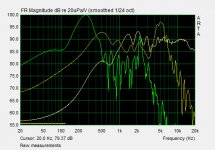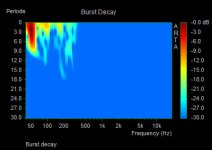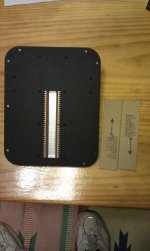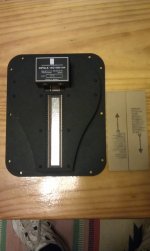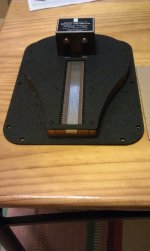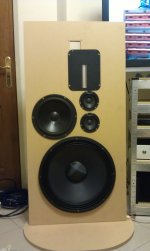It sounds just fine to me. I have tried other solutions for mid-bass without any particular success. It did have an array of eight 10" covering some ~100 to ~300 Hz. Actually, the big 21" H-frames were better to my ears.
Others do run woofers and especially midranges way above the dipole peak, and we are talking several octaves.... I would not do that because the off-axis response gets weird, but from the dipole peak and down the dipole figure-8 pattern is there, but not above.
Others do run woofers and especially midranges way above the dipole peak, and we are talking several octaves.... I would not do that because the off-axis response gets weird, but from the dipole peak and down the dipole figure-8 pattern is there, but not above.
Things are not simple with OB at all! 🙂 That's why its to fun to do I guess...
A lot of EQ is required to make it work properly, that's for sure. To build a dipole with drivers operating only below the dipole peak is very difficult, and it results in 4- or 5-way system.
A lot of EQ is required to make it work properly, that's for sure. To build a dipole with drivers operating only below the dipole peak is very difficult, and it results in 4- or 5-way system.
Thanks StigEric but the math is way too complicated for me to follow, so I will need to find a dummies guide to H frames.
Studiotech pointed me in the direction of a PDF, hopefully it is a little easier to follow.
Jerome,Yes 100Hz is an experimental approximative number when you use 2x10" in the H Frame 😉 It is just a point of reference for discussion.
I use 2x10" drivers in a H frame up to 400 Hz - without complaints. And that is almost one octave below the dipole peak. I would be thankfull if you could give the slightest hint, what kind of physics forbids going beyond 100 Hz. 😕
Rudolf
Rudolf : Stored energy... I made this project :
http://www.diyaudio.com/forums/multi-way/123512-ultimate-ob-gallery-68.html#post2643791
And I heard something wrong in the mid, and I notice a lot of stored energy (see attachments).
Easy for me to conceive, a mass of air cannot do mid, but good for bass.
I'm not alone to think this, See also the build discussions the S20z project of Gainphile on HT guide
Gainphile: S20-Z Compact Open Baffle using Zaph Kit
Why Linkwitz doesn't go up to 120Hz and now 90Hz with his Orion 4 ?
As I said some people can support the sound like MJK, you ? but for my ears the sound is not right. It can have exceptions but I have not heard it.
http://www.diyaudio.com/forums/multi-way/123512-ultimate-ob-gallery-68.html#post2643791
And I heard something wrong in the mid, and I notice a lot of stored energy (see attachments).
Easy for me to conceive, a mass of air cannot do mid, but good for bass.
I'm not alone to think this, See also the build discussions the S20z project of Gainphile on HT guide
Gainphile: S20-Z Compact Open Baffle using Zaph Kit
Why Linkwitz doesn't go up to 120Hz and now 90Hz with his Orion 4 ?
As I said some people can support the sound like MJK, you ? but for my ears the sound is not right. It can have exceptions but I have not heard it.
Attachments
I asked Tc Sounds for a frequency response but to date they haven't responded to my request. What does the dipole peak look like?
You're still not doing any measurements?! Speculation is ok fwiw, but hard data is necessary when building a speaker whether it's a dipole or anything else.
OK, Jerome
your "Ultimate OB" H frame is 40 cm wide and 40 cm deep. Mine is 30 cm wide and 20 cm deep. So any "trouble area" should be moved to higher frequencies, right?
Rudolf
your "Ultimate OB" H frame is 40 cm wide and 40 cm deep. Mine is 30 cm wide and 20 cm deep. So any "trouble area" should be moved to higher frequencies, right?
Rudolf
40x40 should place the dipole peak around 300 Hz.
My own H-baffles are 60x60 cm, and the peak is at approx 200 Hz.
My own H-baffles are 60x60 cm, and the peak is at approx 200 Hz.
Yes Erik you are right, see the response curve 😉
Ok Rudolf, yes you push higher "the trouble area" (~500-600Hz ?) but 400Hz is still high ?
Ok Rudolf, yes you push higher "the trouble area" (~500-600Hz ?) but 400Hz is still high ?
I saw the curve. The peak is big, but since the peak is not a resonance, EQ should fix it perfectly.
Yes I can fix the peak (it is a resonance ? no? the load/mass of air in front and back of the drivers is visco-elastic ? ) but it is difficult to fix the phase/group delay.
Yes I can fix the peak (it is a resonance ? no? the load/mass of air in front and back of the drivers is visco-elastic ? ) but it is difficult to fix the phase/group delay.
No, its not really a resonance. The peak is caused by the front and rear radiation summing in-phase.
Have you measured the phase and group delay?
Got home and did a bit of a mod to the test baffle. I moved the top 12MU to below the 2nd 12MU (making the 2nd 12MU the top). I then put the new RAAL dipole partially into the old top hole. Which now makes the tweeter a little closer to ear height.
Here are a couple of pics of the new dipole and the moded baffle. Yet to do any real testing but very first impressions are promising.
Here are a couple of pics of the new dipole and the moded baffle. Yet to do any real testing but very first impressions are promising.
Attachments
No, its not really a resonance. The peak is caused by the front and rear radiation summing in-phase.
Have you measured the phase and group delay?
Yes I understand. But it looks a 1/4 wavelength resonance. Imagine the 1/2 x (2xU) tube as a pipe ... It looks like a transmission line ?
And Yes I made measurement and I have the SPL response, phase and group delay. But honestly I didn't need measurements to hear the problem.
To return to the original thread : It is big the dipole tweeter 😱 it sounds good ?
Member
Joined 2009
The dipole peak expressed by the math formula is indeed impossible to work with but lets not forget that it is an extreme case modeled for circular baffles.
In practice things like the baffle size and shape as well as the position of the driver can help smooth out the dipole peak. It's worth spending a few minutes with the Edge baffle simulator to gain some perspective on the issue. In some configurations the dipole peak is severe but in others is quite usable.
I have no hard evidence but I even speculate that some drivers have more usable dipole peak at certain frequencies due to their mechanical construction. Parameters such as the magnet shape and the cone profile can affect the dipole characteristics.
In practice things like the baffle size and shape as well as the position of the driver can help smooth out the dipole peak. It's worth spending a few minutes with the Edge baffle simulator to gain some perspective on the issue. In some configurations the dipole peak is severe but in others is quite usable.
I have no hard evidence but I even speculate that some drivers have more usable dipole peak at certain frequencies due to their mechanical construction. Parameters such as the magnet shape and the cone profile can affect the dipole characteristics.
The "worst" example I've seen myself is an 11 dB tall dipole peak right in the midrange at 650 Hz. But it was successfully equalized with no audible trace of the peak....
To return to the original thread : It is big the dipole tweeter 😱 it sounds good ?
Really not sure what to make of it at the moment. I seem to have inherited some contradictory traits…
The speaker seems more directional now than before, but at the same time sounds more open. I was just wondering if it now sounds more directional because I moved the top 12MU and the blending of the drivers is causing it to sound more source specific.
The other thing I noticed is that it really doesn’t seem to make any difference where I cross the tweeter / mids over.
With the monopole tweeter it made a huge difference when mounted on the baffle. Now I can cross over anywhere from 2000Hz to 4000Hz and can barely pick an audible difference.
I do have a theory about this that I need to try out… I think because the dipole tweeter is 2dB less sensitive than the monopole, I think the sound of the mids is drowning out the tweeter and is why I can’t pick it crossing over.
I don’t like the new sound all that much, but I don’t think it is the tweeter that is too blame, I think it is a result of putting the drivers too close together.
When mounted on a ¾” (19mm) MDF board the front and back faces are fairly flush. What I did find interesting is that the dipole tweeter uses the same aluminium element to radiate in both directions, same as a regular driver (I was expecting two elements for some strange reason, which makes no sense).
Really not sure what to make of it at the moment. I seem to have inherited some contradictory traits…
I don’t like the new sound all that much, but I don’t think it is the tweeter that is too blame, I think it is a result of putting the drivers too close together.
You can't get them too close together. Technically, the closer the better for intergration at the crossover point. This should not be the problem. Have you measured anything yet?
- Status
- Not open for further replies.
- Home
- Loudspeakers
- Multi-Way
- First time OB builder
